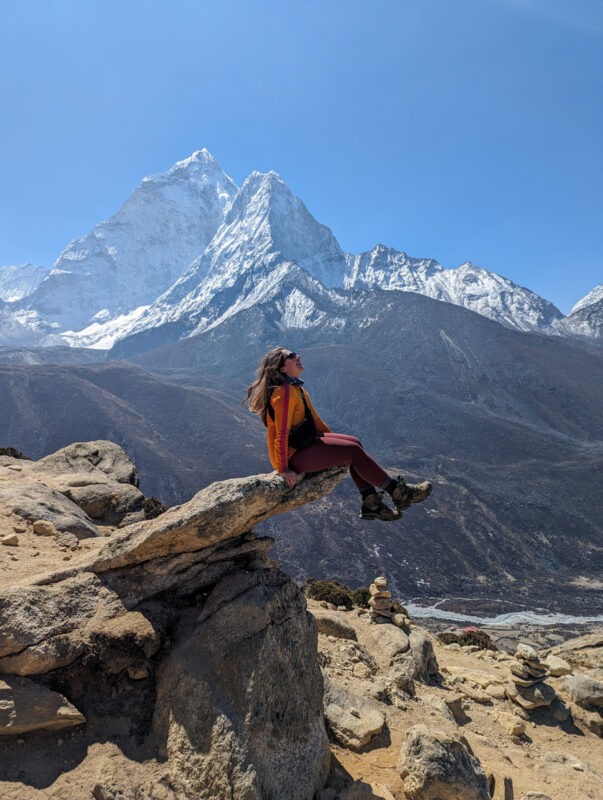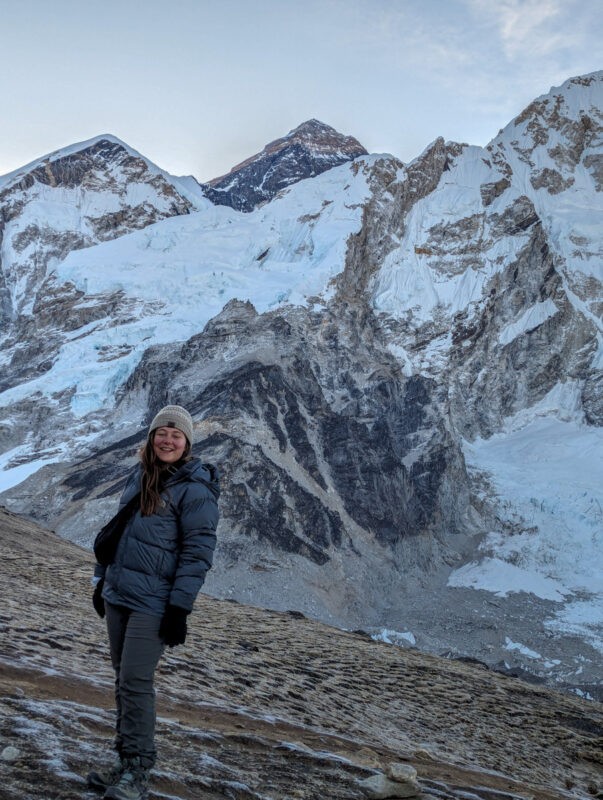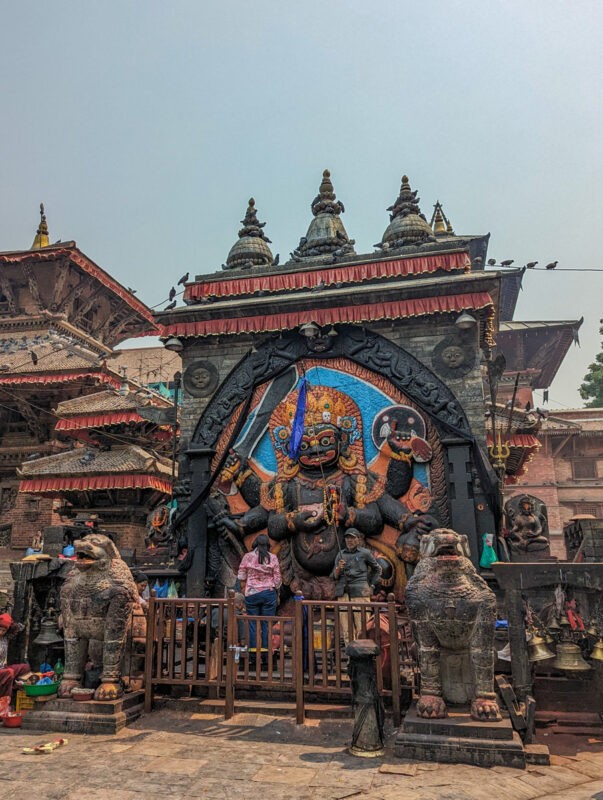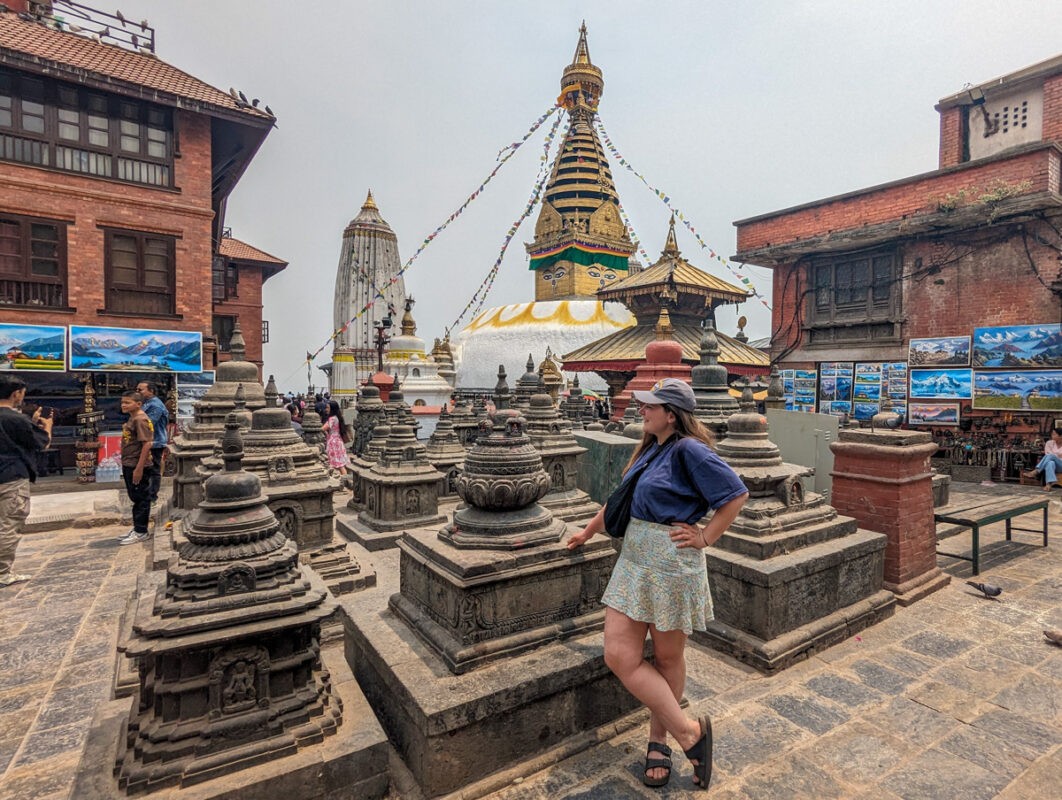Is Nepal safe for travel? Yes, but there are a few things to consider before planning a trip here!
I recently returned from my first trip to Nepal, and before visiting I had a few questions about the country’s safety.
So I endeavoured to write up all of my thoughts on Nepal safety and put them together in this blog post.
Here’s everything you need to know when asking “Is Nepal dangerous or safe?”.
Is Nepal safe?

Generally, Nepal felt safe to me.
The people are friendly and helpful, but there are some things to bear in mind when it comes to road safety, food and drink, solo female traveller safety, altitude sickness, natural disasters and hiking safety.
Road safety

Probably the biggest danger that you’re going to face in Nepal is its roads.
They’re not dangerous per se – nearly all journeys are completed without incident – but the winding mountain roads definitely see more crashes per year than in many other countries around the world.
It’s difficult to recommend how to stay safe on the roads, because by and large, you are at the whim of the driver – and some of the roads are downright tough to drive on.
If you’re really nervous, I’d recommend hiring private drivers rather than taking buses and speaking to the company about the fact that you’re worried about the roads. They’ll likely tell the driver to be extra careful, or they may even take you on an alternative route.
Flights

While they’re safer than the roads, Nepal is home to some rather sketchy airports.
Tenzing-Hilary Airport, in the village of Lukla, is the gateway to Mount Everest and nearly all tourists who hike to Everest Base Camp land here. It’s known as the “world’s most dangerous airport” because it has a very short runway (just over 500 metres) and is positioned precariously at the edge of a cliff.
Plus, at 2,800 metres altitude, it’s victim to a lot of temperamental weather!
But that said, there hasn’t been a fatal incident involving a commercial plane since 2008; while of course that is one too many, the statistics are in your favour if you are hiking Everest Base Camp and have to fly via Lukla.
I really didn’t want to take the Lukla flight when I went to EBC, but it wasn’t too bad. You can read about my full experience here.
There is the occasional plane crash in other areas of Nepal – notably, there was one in 2023 in Pokhara. However, while they do happen every so often, they are newsworthy when they do.
Air travel is very common in Nepal – some of the mountainous areas are so remote, plane is the only feasible transport method. Nearly 300 domestic flights take off and land daily from Kathmandu airport alone.
So statistically, the chance of getting in a plane accident when here is very, very low (lower than driving in your home country!), even if air travel isn’t as safe as other countries around the world.
Social safety

I found Nepal to feel quite safe in terms of social safety.
On the Everest Base Camp trail, there was a strong sense of community and everybody was extremely kind and helpful. Nepalese people are lovely anyway, but as tourism brings most of the income to Sherpa communities on the trail, it feels even safer for tourists here.
I also generally felt quite safe in Kathmandu. We walked around the city and didn’t experience any situations that made us feel unsafe, and generally, market vendors weren’t pushy at all.
I can’t speak for everywhere in Nepal, as I only went to the base camp trail and Kathmandu, but reports from friends state that Pokhara and Chitwan had a similar atmosphere.
Crime rate in Nepal
The crime rate in Nepal is generally significantly lower than that of the US.
For example, the murder rate in the US is 16x higher than that of Nepal!
You can take a look at the crime rates compared here, but generally I would feel a lot safer in terms of crime in Nepal than I would in most places in the US.
Solo female traveller safety in Nepal

I travelled with my partner the whole time I was in Nepal, so I can’t speak too much for its safety for solo female travellers, but I did venture out a couple of times on my own in Kathmandu.
Generally, I found that I didn’t attract too much attention in and around Thamel, which is the touristy part of Kathmandu.
I was asked a couple of times by men where I was going/ what I was doing, but it felt much more manageable than in other cities in the world (including Vienna and Paris).
Food and drink

While Nepali food is amazing, I unfortunately did get sick a couple of times when I was there!
Differing bacteria, hygiene measures or even alternative cooking methods or even ingredients you aren’t used to can cause travellers to get sick of the food and drink when travelling around the country.
I was unwell once on the Everest Base Camp trail (this may have been altitude-related though – more on that below) and on my last day in the country.
There’s not really any way to completely avoid this, but I would recommend the following to lessen your chances of getting sick:
- Avoid salads and raw veg that may have been washed in tap water.
- Double check that any ice is made from filtered water (in Kathmandu and the other cities, it usually will be).
- Be very careful with meat.
- Make sure food is served piping hot.
- Don’t go anywhere near the tap water – use a Water to Go Bottle for clean drinking water or just stick to bottled water.
Read more about traveller’s diarrhoea here.
Healthcare in Nepal

Private healthcare is decent in Nepal, but nearly all of the reputable private hospitals are in Kathmandu – so if you fall unwell elsewhere in the country, you may be transported back to the capital for treatment (this is why coverage for heli evacuation is really important!).
I did end up receiving hospital treatment in Nepal – I woke up three days after our Everest Base Camp hike and was covered in hives.
I saw a doctor, who quickly told me that I needed an IV drip, and had steroids and antihistamines which thankfully treated them straight away.
I had treatment at ERA International Hospital, and generally, I thought they were very good – it was very clean, all staff spoke excellent English, test results were available quickly and all doctors seemed very knowledgeable.
However, it was expensive – I paid over £300 for treatment. Luckily I can claim £200 of this back on my insurance – another reason to have comprehensive travel insurance!
Altitude sickness

If you’re heading to the mountains (and you really should be if you’re in Nepal!) then make sure you’re fully aware of the dangers of altitude sickness.
I’ve covered this further in my Everest Base Camp safety post; it’s the biggest danger that you’ll face when trekking in mountainous regions.
Basically, if you start feeling unwell (mainly if you have a headache, nausea, vomiting and dizziness) when trekking at altitudes higher than 2,500 metres, let a guide or someone in a tea house know.
These symptoms may not mean you need to descend, but you may not be able to go higher until they ease. If they worsen or don’t go away, or if you feel any symptoms of Acute Mountain Sickness (including more severe symptoms of altitude sickness, hallucinations, coughing up blood), then you may need to descend.
Diamox can help – this is an altitude sickness medication. Not everyone can take Diamox, so it’s a good idea to speak to your doctor about this before travelling. I’d recommend packing it just in case you need it.
Other than that, make sure you have really good insurance that will cover you for trekking over 4,500 metres and include heli-evacuation. I usually use SafetyWing, but couldn’t for my Nepal trip as they didn’t have the right cover. Instead, I went for True Traveller Insurance, who specialise in Everest Base Camp and Nepal hiking insurance.
Natural disasters

Sitting at fault lines, Nepal is no stranger to natural disasters. It was hugely impacted by a 2015 earthquake which killed nearly 9,000 people.
An earthquake of this scale is very rare, however – there was one in 1988 that killed around 700 people and one in 1980 with a mortality rate of around 200. There have also been a few over the years that have killed less than 100 people.
Again, any fatalities from earthquakes are too many, but the statistics do demonstrate that the chances of getting involved in one are minimal.
Avalanches in the Himalayas are perhaps more of a risk; they do happen, although they aren’t common on well-trodden trekking routes (for example, they are a big risk on Annapurna Mountain, but the circuit and base camp routes are usually safe – although avalanches do happen occasionally).
However, I’d recommend staying up to date with the avalanche risk and following instructions from your guide when trekking anywhere in Nepal.
Trekking safety in Nepal

Most of the well-trodden routes – Everest Base Camp, Annapurna Circuit, Langtang Valley – are safe for trekkers. Some drops can be sheer, but as long as you use common sense and don’t get close to the edges, you shouldn’t have a problem with them!
Altitude sickness is the biggest issue, as discussed above.
I’d recommend staying as safe as possible by hiking with a guide. Recently, Nepal passed a law stating that guides are essential for anybody trekking in the country.
Technically you don’t need a guide for Everest Base Camp, but I couldn’t imagine doing the trek without one!
Safety tips for Nepal

Wondering how to stay safe in Nepal?
Here are some essential safety tips for Nepal that I’d recommend you follow.
- Choose Reliable Transportation: Opt for private drivers or reputable bus companies when travelling on Nepal’s roads, especially on winding mountain routes. Communicate your safety concerns to ensure a cautious approach to driving.
- Prepare for Flights: Select well-regarded airlines, especially for flights to challenging locations like Lukla. Check weather conditions and opt for morning flights when the weather is usually clearer.
- Be Street Smart in Cities: While generally safe, it’s wise to remain vigilant in urban areas like Kathmandu and Pokhara. Avoid walking alone at night and keep your belongings secure.
- Respect Local Customs: Engage with the local culture respectfully. Understanding and adhering to local customs will enhance your interactions and safety.
- Stay Healthy: Be cautious with food and water. Avoid raw vegetables, ensure meat is cooked thoroughly, and drink only bottled or filtered water to prevent illness.
- Manage Altitude Sickness: Be aware of the symptoms of altitude sickness and take it seriously by acclimatising properly and considering medication like Diamox after consulting with a doctor.
- Prepare for Natural Disasters: Stay informed about potential natural risks such as earthquakes and avalanches, especially when trekking in remote areas.
- Travel with a Guide: Especially in remote trekking areas, a knowledgeable guide is invaluable for safety, from navigating paths to handling emergency situations.
- Secure Comprehensive Travel Insurance: Ensure your insurance covers high-altitude trekking and includes provisions for emergency evacuation and medical expenses.
- Carry Emergency Contacts: Always have a list of emergency contacts, including local authorities and your embassy, readily accessible.
So, is Nepal safe?
Yes, largely Nepal is safe.
Follow my tips in this blog post, and it’s highly likely that you’ll have a hassle-free trip.
Want more free travel tips? I’ve been covering my trip to Nepal on Instagram and TikTok and will soon be posting videos on YouTube as well. Please do follow along!

